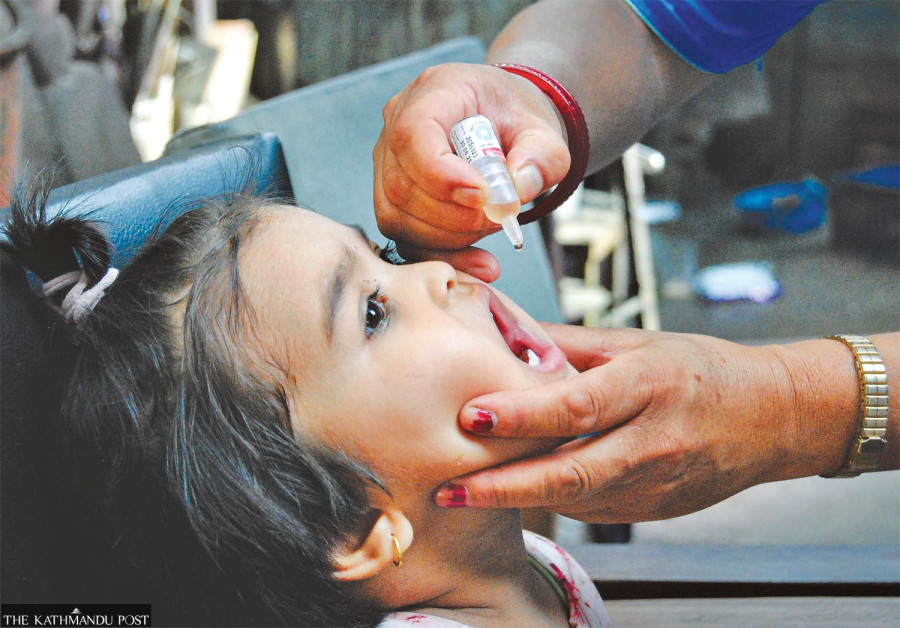Health
Valley polio drive hits 104% coverage, but experts warn of gaps
Refugees, floating populations, and slum dwellers main challenge to effective immunisation, officials say.
Arjun Poudel
The polio immunisation drive launched in the Kathmandu Valley a week ago has achieved an impressive 104 percent coverage rate.
This is not the first time coverage rate of a healthcare campaign has exceeded 100 percent.
What concerns public health experts is that even if the coverage of the health campaign exceeds 100 percent every time, post-campaign surveys reveal actual coverage falling short.
“We don’t have the exact count of the floating population or those living in the city slums,” said Dr Arjun Spkota, chief of Health Office Kathmandu. “Moreover there are refugees in the capital. Providing healthcare programmes to these groups is always a challenge. Chances of children missing vaccination or other health campaigns is always high in big and crowded cities like in the Kathmandu Valley.”
Health authorities launched a special immunisation programme in the three districts of the Valley—Kathmandu, Lalitpur and in Bhaktapur—following the detection of a highly contagious poliovirus in sewage samples.
Officials say that presence of type-3 poliovirus in sewage samples has been confirmed by the National Institute of Health of Thailand, a World Health Organisation’s collaborating centre. The virus, which originated from a vaccine, was detected in sewage samples collected from the confluence of the Tukucha and Bagmati Rivers [in Kathmandu] on May 26, according to them.
Nepal has been polio-free since 2010, but was officially declared polio-free by the World Health Organisation only on March 27, 2014, after maintaining zero polio cases for three consecutive years.
After having zero human cases of polio for about 14 years, the infectious disease has surfaced in the capital city’s sewage, which is a serious problem, according to public health officials. They said that the presence of poliovirus in sewage samples indicates the looming risk of an outbreak.
The Immunisation Section at the Family Welfare Division under the Department of Health Services had planned to carry out a four-day polio vaccination in all three districts of the Valley from July 24 but later extended for a week.
All children under five years of age have been inoculated with an additional dose of oral polio vaccine in the drive.
Oral polio vaccine, which consists of Type-1 and Type-3 polioviruses have been administered during the campaign. Health workers and female community health volunteers were deployed to homes, schools, bus parks, and entry points to ensure that no eligible children miss the vaccine.
“We found over 3,000 children living in city slums,” said Dr Abhiyan Gautam, chief of the Immunisation Section. “We are aware that children might still miss the vaccine despite our best efforts to meet the target.”
The health ministry said that the vaccine coverage rate for polio is 95 throughout the country. An estimated 300,000 children live in three districts of the Valley. But the 104 percent coverage rate shows that more children reside in the Valley than estimated. Health authorities do not have exact data on the people residing in the city slums.
Floating population, scattered slums, high density of working-class people, and lack of awareness and poor access to health services are some of the challenges identified in improving health indicators, experts say. They urge the authorities to focus on high-risk groups when designing health programs, as vulnerable populations are always disproportionately affected during disease outbreaks.
Doctors say the poliovirus mainly affects children and is usually transmitted through droplets or aerosols from the throat and by faecal contamination of hands, utensils, food and water. Those who do not wash their hands properly, and those who consume contaminated food and water or reside in an area where water and sanitation conditions are poor are at high risk of getting infected with the virus.
Experts urge health authorities to carry out post-campaign surveys to know the actual coverage of the campaign.
“Achieving 104 percent coverage is more of an administrative number,” said Upreti, former director general, who is also a child health expert. “Health authorities must carry out a post-campaign survey to reveal the true picture.”
Regular immunisation is one of the most successful programmes in Nepal, boasting a high coverage rate. The country has made remarkable progress in reducing the under-five mortality rate and the regular immunisation programmes are credited with this achievement.




 20.12°C Kathmandu
20.12°C Kathmandu














